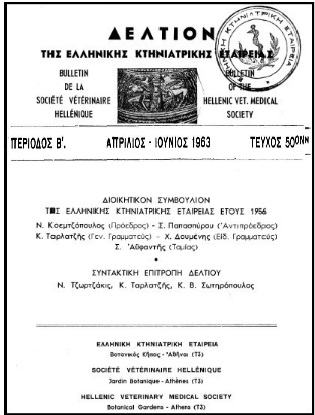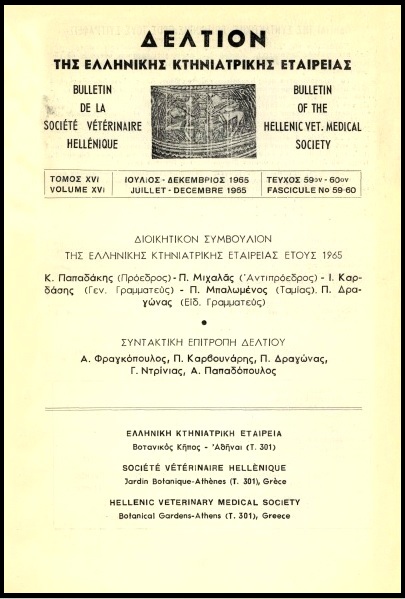TRIALS OF FOOT-AND-MOUTH DISEASE VACCINATION AND POTENCY TESTS IN GOATS
Resumen
4 batches of Foot - and - Mouth Disease (FMD) vaccine were assayed in adult goats, from local breedings, serologically positive for Brucella. These goats were to be slaughtered, in accordance with an eradication program. The viremia was checked by using the plaque forming unit (PFU) and the cytopathic effect methods, every 24 hours for 3 days post—inoculation and it has been found that it is variable both in intensity and duration. In the controls the viremia was detected in 4/5 to 5/5 of the animals whereas in the vaccinated animals it dependent on the dose of vaccine and on virus units (104 to 105 ) used, for the infection. The neutralizing antibody titres after vaccination were generally lower than those observed in cattle and sheep and they varied significantly among the animals vaccinated with the same dose. This is in accordance with the findings of a preliminary work where the titres were also low and they were then attributed to the young age of the animals used. The titres were about the same in the groups vaccinated with undiluted or diluted 1/4 vaccine and lower in those vaccinated with 1/16 of the normal dose. The revaccination carried out 3 weeks after the first vaccination increases the antibody titre as well as the resistance of animals to challenge. It was observed that an increase of the antibody titres resulted in a decrease of the percentage of animals positive to viremia but this percentage was still significant even in goats with high antibody titres.
As regards to the generalization of the disease it was not so frequent when the infection was made with 104 to 105 DL^ FMD virus and it mostly affected the animals partially, on 1, 2 or 3 feet. With the use of higher doses of virus (10-6 · 50) the resistance of the animals appeared to be overcome by the infection. Sometimes, despite the high titres (1,87 and 1,95) of antibodies, viremia occured whereas in some animals with generalized lesions the viremia was not detected. This last fact may be due to the temporariness of the viremia or its eventual late appearance. As a conclusion we consider that viremia detection may be used for estimating the potency of FMD vaccine in goats, when the animals are infected with 104 to 105 DL5 0 FMD virus.The generalization of the disease must also be taken into account in cases that viremia is not detected. So the 4 vaccine batches, of a protective dose 50% for guinea pigs {0.25, (0.14, 0.12 and 0.48 ml, when tested on goats, their protective dose 50% was respectively 0.50, <1 , 1.25 and 0.47ml. If both viremia and generalization are taken into account, then the protective dose 50% for goats were respectively 0.50, <1 , 1.25 and 0.96 ml.
Article Details
- Cómo citar
-
ΠΑΠΠΟΥΣ Χ., ΜΠΡΟΒΑΣ Δ., & ΚΑΡΑΒΑΛΑΚΗΣ Ι. (1972). TRIALS OF FOOT-AND-MOUTH DISEASE VACCINATION AND POTENCY TESTS IN GOATS. Journal of the Hellenic Veterinary Medical Society, 23(3), 159–175. https://doi.org/10.12681/jhvms.20071
- Número
- Vol. 23 Núm. 3 (1972)
- Sección
- Articles

Esta obra está bajo una licencia internacional Creative Commons Atribución-NoComercial 4.0.
Authors who publish with this journal agree to the following terms:
· Authors retain copyright and grant the journal right of first publication with the work simultaneously licensed under a Creative Commons Attribution Non-Commercial License that allows others to share the work with an acknowledgement of the work's authorship and initial publication in this journal.
· Authors are able to enter into separate, additional contractual arrangements for the non-exclusive distribution of the journal's published version of the work (e.g. post it to an institutional repository or publish it in a book), with an acknowledgement of its initial publication in this journal.
· Authors are permitted and encouraged to post their work online (preferably in institutional repositories or on their website) prior to and during the submission process, as it can lead to productive exchanges, as well as earlier and greater citation of published work.













